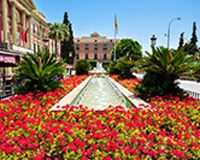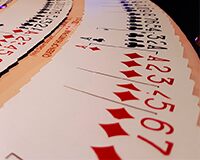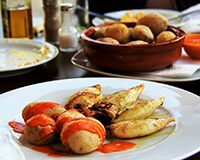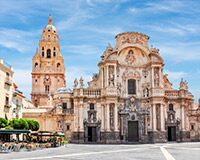What to see in Murcia in a day

The city of Murcia is the perfect size to visit in a single day. The compact city centre, the lively atmosphere and the mild climate make this a most attractive destination for visitors at any time of year.
The city of Murcia offers attractions ranging from museums and historic monuments to interesting leisure activities, such as theatres, bars and markets.
We’re going to start our one-day visit to Murcia at its cathedral, the city’s most important monument and therefore a not-to-be-missed sight for us. After that, an easy stroll through the centre to see the interesting buildings, the streets, and the squares of the city’s historic quarter.
Itinerary day 1
12.00 - 12.15
The Town Hall and Puente Viejo
Almost next door stands Murcia’s Town Hall, built in a neo-Classical style, and the river Segura. Here you can see the Puente Viejo [the Old Bridge], the city’s oldest bridge, and then the Puente Nuevo [New Bridge] which, despite its name, is Murcia’s second-oldest bridge.
13.30 - 15.00
Plaza de las Flores
Now it’s time for lunch, and nothing can beat stopping off in one of Murcia’s best tapas areas, the popular Plaza de las Flores, for a gastronomic experience. The square has any number of terraces where you can eat very well at a reasonable price. Some of the area’s best-known bars include El Parlamento Andaluz, El Pulpito, El Pasaje de Zabalburu, and La Tapeoteca
12.30 - 13.30
Mercado de Verónicas
Following the course of the river Segura, we come to the Mercado de Verónicas, the elegant, Modernista market square in the centre of Murcia. Dating back over a hundred years, it is still one of the most popular spots in the city with visitors and locals alike. It has over 100 stalls displaying meat, fish, sea food, and locally-grown produce. It is now midday, the ideal time to experience the buzz and activity of a market like this, but also to whet the appetite with an aperitif, as a number of establishments will prepare the foods you have just purchased in the market.
18.30 - 19.30
Murcia’s Casino
We have kept back the sophisticated ambience of Murcia’s Real Casino [Royal Casino] until the end of the day, so that we can enjoy a drink in its restaurant. The Casino is one of Murcia’s most famous buildings with a unique architecture, thanks to its combination of styles ranging from neo-Baroque to neo-Nazari, the latter represented here by the splendid Arab Courtyard.
20.30 - 22.00
Dinner at Los Zagales
After our stroll through the centre of Murcia, we return to the area near the cathedral. We recommend you have dinner at the historic bar, Los Zagales, which opened in 1926, and which enjoys classic status among the citizens of Murcia. This extremely famous temple to Murcian gastronomy fills up quickly, so we recommend you arrive early. And obviously, make sure you try some paparajotes [dessert made with lemon leaves coated with a dough made from flour and egg, then fried and sprinkled with sugar and cinnamon], and that you also order zarangollo [a traditional egg-based dish] and pelotas [Murcian meatballs]. An essential visit in Murcia!
17.30 - 18.30
Calle Trapería
Just a few yards from Santa Clara is Calle Trapería, one of Murcia’s best-known and popular streets. This pedestrian thoroughfare is perfect for an afternoon’s shopping, and for discovering traditional local businesses. Calle Trapería takes its name from the trade in fabrics [trapos] which thrived here during the fourteenth century. Nowadays, Calle Trapería is one of Murcia’s main shopping areas, as well as home to some of the city’s fine examples of Modernist architecture, including the Casino, the Edificio de la Alegría de la Huerta, and the Sociedad de Cazadores. But of course you don’t have to confine yourself to Calle Trapería. Other, neighbouring streets, such as Calle Platería and Calle Jabonería [Silversmiths’ Street and Soapmakers’ Street], also have interesting shops, including jewellers and boutiques.
15.00 - 15.30
Romea Theatre
After lunch, a five-minute walk will bring us to Romea Theatre, Murcia’s principal theatre, which first opened in 1862. This theatre has an outstandingly beautiful neo-Classical façade, an exquisite seating area, and a breathtaking ceiling. If you’d like to see a performance during the evening, make sure you consult the programme beforehand.
16.00 - 17.00
Convento de Santa Clara
Behind Romea Theatre stands the Convento de Santa Clara, one of Murcia’s most important historic buildings. This was once the site of the old Arab fortress, a vestige of which has been passed down to us in the form of the monastery’s large pool. But this has also been the royal residence of Christian Kings. The tour of the convent of Santa Clara includes the church, the gardens and the museum — which houses significant architectural remains such as carvings, capitals and plinths, as well as collections of religious art and Islamic pieces.
10.00 - 12.00
Murcia´s Cathedral
Murcia’s Cathedral is our starting point. This jewel of the Baroque is distinguished by its bell tower, at 93 metres the second tallest in Spain after the Giralda. The Cathedral of Santa María is an essential visit. Its main façade is so impressive that you might think it will outdo anything you’ll see inside. But inside, the chapels of Los Vélez and of Junterón are two of the most beautiful parts of the cathedral, together with the tomb of King Alfonso X the Wise. You can combine your tour of the cathedral with a visit to its museum, situated in the cloister and the chapter house, where recent finds are displayed, along with the archaeological remains in the foundations. And next to the cathedral, make sure you spend a little time in Plaza del Cardenal Belluga Junto a la catedral, no dejes de detenerte en la plaza del Cardenal Belluga.









